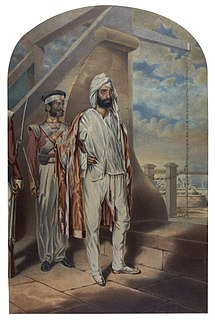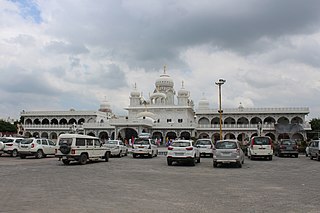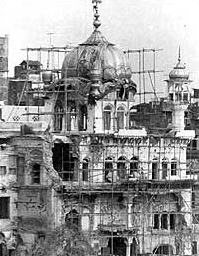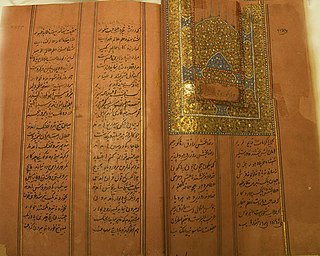 W
WThe 1947–1948 Rajouri Massacres were the targeted killing of thousands of Hindu and Sikh residents and refugees in the Rajouri tehsil in the princely state of Jammu and Kashmir, by the Azad Kashmir Forces and Pashtun tribal militia during the First Kashmir War. The 'siege' of the town of Rajouri began on 7 November 1947 and ended on the 12 April 1948 when the Indian Army recaptured it. The massacre is commemorated annually in Rajouri and the Union Territory of Jammu and Kashmir.
 W
WSultan Jassa Singh Ahluwalia was a prominent Sikh leader during the period of the Sikh Confederacy, being the Supreme Leader of the Dal Khalsa. He was also Misldar of the Ahluwalia Misl. This period was an interlude, lasting roughly from the time of the death of Banda Bahadur in 1716 to the founding of the Sikh Empire in 1801. He founded the Kapurthala State in 1772.
 W
WThe Battle of Aliwal was fought on 28 January 1846 between British and Sikh forces in northern India. The British were led by Sir Harry Smith, while the Sikhs were led by Ranjodh Singh Majithia. Britain's victory in the battle is sometimes regarded as the turning point in the First Anglo-Sikh War.
 W
WThe First Anglo-Sikh War was fought between the Sikh Empire and the East India Company in 1845 and 1846 in and around the Ferozepur district of Punjab. It resulted in partial subjugation of the Sikh kingdom and cession of Jammu and Kashmir as a separate princely state under British suzerainty.
 W
WThe Second Anglo-Sikh War was a military conflict between the Sikh Empire and the British East India Company that took place in 1848 and 1849. It resulted in the fall of the Sikh Empire, and the annexation of the Punjab and what subsequently became the North-West Frontier Province, by the East India Company.
 W
WBaba Jai Lal Ji Ubhi is a Sikh religious figure who is venerated for his religious devotion and service to the fifth Sikh Guru, Guru Arjan Dev Ji.
 W
WThe Battle of Muktsar or Battle of Khidrāne Dee Dhāb took place on 29 December 1705, following the siege of Anandpur. In 1704, Anandpur was under an extended siege by the allied forces of the Mughals and the hill chiefs.
 W
WChaar Sahibzaade is a 2014 Indian Punjabi 3D computer-animated historical drama film written and directed by Harry Baweja. It is based on the sacrifices of the sons of the 10th Sikh guru Guru Gobind Singh—Sahibzada Ajit Singh, Jujhar Singh, Jorawar Singh, and Fateh Singh. Om Puri provided the film's narration, and the voice artists for various characters were kept anonymous. It was also the highest grossing Punjabi film when it was released. It was surpassed by Carry on Jatta 2 in July 2018.
 W
WSri Chand, also referred to as Baba Sri Chand, was the founder of the ascetic sect of Udasi and was the elder son of Guru Nanak, first Guru and founder of Sikhism. He was born to Mata Sulakhani on Bhadra sudi 9, 1551 Bikrami.
 W
WMulraj Chopra was the Diwan of Multan and leader of a Sikh rebellion against the British which led to the Second Anglo-Sikh War.
 W
WThe conversion of non-Islamic places of worship into mosques occurred during the life of Muhammad and continued during subsequent Islamic conquests and under historical Muslim rule. As a result, Hindu temples, Buddhist temples, Christian churches, synagogues, and Zoroastrian fire temples were converted into mosques. The practice has led to conflicts and religious strife in various parts of the world.
 W
WClaude Auguste Court was a French soldier and mercenary.
 W
WDatun Sahib is the name of a tree in the main bazaar at Leh, Ladakh in Jammu and Kashmir, India. Guru Nanak visited this site around 1516. There is no Gurudwara at the site, but the remains of a large meswak tree are located behind the Jamia Masjid in the main bazaar at Leh. The Datun Sahib is located close to the Leh Palace, on a lane which mainly houses bread makers.
 W
WDhadi, also spelled as Dhadhi, is one who sings ballads using Dhadd and Sarangi, the folk instruments of Punjab. According to Kahn Singh Nabha's Mahan Kosh the definition of dhadhi is "One who sings ballads of warriors playing Dhadd". Dhadis are a distinct group performers emerged in the time of Sikh gurus.
 W
WThe Fauj-i-Khas was a brigade of the Fauj-i-Ain section of the Sikh Khalsa Army of Punjab. It consisted of very experienced elites and had separate flag and emblem. It was strictly disciplined on French pattern. All the equipment and weapons were of the best type. It grew to be the best organised section of the regular army (Fauj-i-Ain)
 W
WThe Battle of Gujrat was a decisive battle in the Second Anglo-Sikh War, fought on 21 February 1849, between the forces of the East India Company, and a Sikh army in rebellion against the Company's control of the Sikh Empire, represented by the child Maharaja Duleep Singh who was in British custody in Lahore. The Sikh army was defeated by the British regular and Bengal Army forces of the British East India Company. After it capitulated a few days later, the Punjab was annexed to the East India Company's territories and Duleep Singh was deposed.
 W
WThe Gurdwara Rakab Ganj Sahib is a historic gurdwara near Parliament House in New Delhi. It was built in 1783, after Sikh military leader Baghel Singh Dhaliwal (1730–1802) captured Delhi, on 11 March 1783, and his brief stay in Delhi, led to the construction of several Sikh religious shrines within the city. This one marks the site of cremation of the ninth Sikh Guru, Guru Tegh Bahadur, after his martyrdom in November 1675 for saving Hindu Kashmiri Pandits, under orders of Aurangzeb. The Gurudwara Sahib is built near old Raisina village near Raisina Hill, at present Pandit Pant Marg, took 12 years to build. Prior to that, a mosque had been built near the spot.
 W
WGuru ka Tal is a historical Sikh pilgrimage place dedicated to the memory of ninth Guru Sri Guru Tegh Bahudar Ji. Guru ka Taal is near Sikandra in Agra. The Gurudwara was built over the place where the Guru Tegh Bahadur offered voluntary arrest to Aurangazeb, the Mughal Emperor. Several devotees gather every year to pay homage to the great Sikh guru in this Gurudwara.
 W
W"Guru Maneyo Granth" refers to the historic statement of the 10th Sikh Guru, Guru Gobind Singh (1666–1708) shortly before his demise on affirming the sacred scripture Adi Granth as his successor, thereby terminating the line of human Gurus. Installed as the Guru Granth Sahib, it is now the central holy scripture of Sikhism, and the eternal living Guru of all Sikhs. It is central to Sikh worship as it is said to imbibe the one light of the creator manifested in the Ten Sikh Gurus—one spirit in ten forms.
 W
WGuru Nanak Jhira Sahib is a Sikh historical shrine situated in Bidar, Karnataka. Gurdwara Nanak Jhira Sahib was built in the year 1948 and is dedicated to the first Sikh guru Guru Nanak. Bidar has a very long association with Sikhism as this is the home town of Bhai Sahib Singh, one of the Panj Pyare, who offered to sacrifice their heads and were later baptised as the first members of the Khalsa.
 W
WGurdwara Sis Ganj Sahib is one of the nine historical Gurdwaras in Delhi. It was first constructed in 1783 by Baghel Singh Dhaliwal to commemorate the martyrdom site of the ninth Sikh Guru, Guru Tegh Bahadur. Situated in Chandni Chowk in Old Delhi, it marks the site where the ninth Sikh Guru was beheaded on the orders of the Mughal emperor Aurangzeb on 11 November 1675 for refusing to convert to Islam. The Sikh regiment of the Indian army salute the Sis Ganj Gurudwara after saluting the president of India since 1979, the only instance of saluting twice in the Republic Day parade by a regiment of Indian army.
 W
WJhatka Parkash ,also called Jhatka Parkash Granth, is a book written by Giani Niranjan Singh Saral, a leading preacher of the SGPC, concerning historical, philosophical, etymological and theological aspects of Jhatka and Meat eating in Sikh Religion.
 W
WBibi Rajindar Kaur, also known as Rajindan, was a Sikh princess. In 1778, her first cousin Raja Amar Singh of Patiala was defeated by Hari Singh of Sialba. She led 3,000 soldiers to rescue him. She also defended the city of Patiala against Maratha attacks.
 W
WThe Khalsa Akhbar, Lahore, was a weekly newspaper and the organ of the Lahore Khalsa Diwan, a Sikh society. Published from Lahore in the Punjabi language, the newspaper was established in 1886 and functioned sporadically till 1905. Founded by Bhai Gurmukh Singh, a professor of Punjabi at the Oriental College, Lahore, who also established the Khalsa Press in Lahore, the paper was taken over by Giani Ditt Singh, a scholar and a poet.
 W
WKhalsa Bahadur is an epic poem written by Chuhar Singh describing the chivalry and sacrifice of Sikh soldiers at the Battle of Saragarhi. The poem is 55 pages long, written using the baint verse form, and written in the Punjabi language. It was completed on November 13, 1915 at Ballial in the Patiala district of Punjab (India) using information from Sikh soldiers on leave.
 W
WBhai Nihang Khan was the zamindar ruler of a small principality called Kotla Nihang Khan near Ropar in Punjab, India. He was a friend and follower of the tenth Sikh Guru, Guru Gobind Singh. The Guru and his associates frequently stayed with Nihang Khan, who often sheltered and provided succor to them in the period when they were facing persecution by Mughal forces. By way of faith and ethnicity, Nihang Khan was a Muslim Pathan.
 W
WSikh is the title and name given to an adherent of Sikhism. The term has its origin in the Sanskrit term śiṣya, meaning "disciple, learner" or śikṣa, meaning "instruction".
 W
WBaba Sain Mir Mohammed Sahib, popularly known as Mian Mir or Miyan Mir, was a famous Sufi Muslim saint who resided in Lahore, specifically in the town of Dharampura. He was a direct descendant of Caliph Umar ibn al-Khattab. He belonged to the Qadiri order of Sufism. He is famous for being a spiritual instructor of Dara Shikoh, the eldest son of Mughal emperor Shah Jahan. He is identified as the founder of the Mian Khel branch of the Qadiri order. His younger sister Bibi Jamal Khatun was a disciple of his and a notable Sufi saint in her own right.
 W
WMisl generally refers to the sovereign states of the Sikh Confederacy, that rose during the 18th century in the Punjab region in the northern part of the Indian subcontinent and is cited as one of the causes of the weakening of the Mughal Empire prior to Nader Shah's invasion of India.
 W
WThe Nankana massacre took place in Nankana Sahib gurdwara on 20 February 1921, at that time of British India, in modern-day Pakistan. More than 260 Sikhs were killed, including children as young as seven, by the Mahant and his mercenaries. The event forms an important part of Sikh history. In political significance, it comes next only to Jallianwala Bagh massacre of April 1919. The saga constitutes the core of the Gurdwara Reform Movement started by the Sikhs in early twentieth century.
 W
WOperation Blue Star was the code name of an Indian military action which was carried out between 1 and 10 June,1984, in order to capture the Sikh leader Jarnail Singh Bhindranwale and his followers along with the demolition of the buildings of Harmandir Sahib complex in Amritsar, Punjab. The decision to launch the attack rested with Prime Minister Indira Gandhi, who, according to retired general S.K. Sinha, had been considering the operation for more than 18 months prior, authorizing army preparation for it long before any insurgents were in the complex. In July 1982, Harchand Singh Longowal, the President of the Sikh political party Akali Dal, had invited Bhindranwale to take up residence in the Golden Temple Complex to evade demolition of Sri Akal Takht Sahib. The government said that Bhindranwale later turned the sacred temple complex into an armoury and headquarters.
 W
WOperation Woodrose was a military operation carried out by the Indira Gandhi-led Indian government in the months after Operation Blue Star to kill baptised and religious Sikh Khalsas in the state of Punjab. The government arrested all prominent members of the largest Sikh political party, the Akali Dal, and banned the All India Sikh Students Federation, a large students' union. In addition, the Indian Army conducted operations in the countryside during which thousands of Sikhs, overwhelmingly young men, were detained for interrogation and subsequently tortured. Despite its purported success in controlling the armed insurgency in the Punjab region, the operation was criticized by human-rights groups for the suspension of civil liberties and habeas corpus, resulting in the disappearances of thousands of Sikh men. After the operation, the central government was criticized for using "draconian legislation" to repress a minority community.
 W
WThe Insurgency in Punjab that started in the early 1980s, was an armed campaign against the Government of India by the Sikh nationalist Khalistan movement. In the 1980s, the movement had developed into a secessionist movement. The Green Revolution brought several social and economic changes which, along with factionalism of the politics, in the Punjab state increased tension between rural Sikhs in Punjab with the union Government of India. Pakistani strategists then began supporting the militant dimension of the Khalistan movement.
 W
WSheikhan City is situated in District Chiniot in Punjab province of Pakistan.
 W
WRaja Dina Nath Madan (Razdan) (1795–1857) aka Diwan Dina Nath or Dina Nath, who was a Kashmiri, rose to the position of the Privy Seal and finance minister (Diwan) in the Punjab empire of Maharaja Ranjit Singh.
 W
WPir Budhan Shah, also called Baba Budhan Ali Shah, was a venerated Sufi pir who had religious discourse with Guru Nanak in Rawalpindi and later accepted Gurmat thought during times of Guru Har Gobind.
 W
WShaheedi Sabha is three-day annual religious congregation (get-together) organised every year in December at Gurdwara Fatehgarh Sahib, in the Fatehgarh Sahib district of Punjab, India to pay homage to the martyrdom of Chhotte Sahibzade Baba Zorawar Singh and Baba Fateh Singh, the youngest sons of the 10th sikh guru Guru Gobind Singh.
 W
WThe Sikh Empire was a state originating in the Indian subcontinent, formed under the leadership of Maharaja Ranjit Singh, who established a secular empire based in the Punjab. The empire existed from 1799, when Maharaja Ranjit Singh captured Lahore, to 1849 and was forged on the foundations of the Khalsa from a collection of autonomous Sikh misls. At its peak in the 19th century, the Empire extended from the Khyber Pass in the west to western Tibet in the east, and from Mithankot in the south to Kashmir in the north. Religiously diverse, with an estimated population of 3.5 million in 1831, it was the last major region of the Indian subcontinent to be annexed by the British Empire.
 W
WSikhs served in the British Indian Army throughout the British Raj. Sikh units fought at the Battle of Saragarhi; in the First World War, as the "Black Lions", as well as during the Second World War in Malaya, Burma and Italy.
 W
WKanwar Sri Bikrama Singh Bahadur (1835–1887) was a 19th-century Sikh leader.
 W
WColonel the Honourable Kanwar Pratap Singh Bahadur of Kapurthala was a Punjabi politician and scholar.
 W
WMaharaja Ranjit Singh, popularly known as Sher-e-Punjab or "Lion of Punjab", was the leader of the Sikh Empire, which ruled the northwest Indian subcontinent in the early half of the 19th century. He survived smallpox in infancy but lost sight in his left eye. He fought his first battle alongside his father at age 10. After his father died, he fought several wars to expel the Afghans in his teenage years and was proclaimed as the "Maharaja of Punjab" at age 21. His empire grew in the Punjab region under his leadership through 1839.
 W
WSri Muktsar Sahib is a city and district headquarters for the district of Sri Muktsar Sahib, located in Punjab, India. The 2011 Census of India put the total population of Sri Muktsar Sahib municipality to 117,085, making it the 14th largest city of Punjab, in terms of population. Historically known as Khidrana or Khidrane di dhab, the city was made the district headquarters in 1995. Chronological evidence indicates that the city was named Muktsar after the battle of Muktsar in 1705. The government officially changed the name of the city to Sri Muktsar Sahib in 2012, though the city is still primarily referred to by its unofficial name – Muktsar.
 W
WVirasat-e-Khalsa is a museum of Sikhism, located in the holy town, Anandpur Sahib, near Chandigarh, the capital of the state of Punjab, India. The museum celebrates 500 years of the Sikh history and the 300th anniversary of the birth of Khalsa, based on the scriptures written by the tenth and last human guru, Guru Gobind Singh Ji. It serves to attract tourists and pilgrims. This results in a consultation between religion and emerging need in the building environment. One side it promotes hand crafts to locals as well as nurturing a sense of heritage, besides it recalls to infinity by the volumetric interference of existing skyline is another phase of a visible Urbanism dilemma.
 W
WThe Zafarnāma was a spiritual victory letter sent by Sri Guru Gobind Singh Ji in 1705 to the Mughal Emperor of India, Aurangzeb after the Battle of Chamkaur. The letter is written in Persian verse.